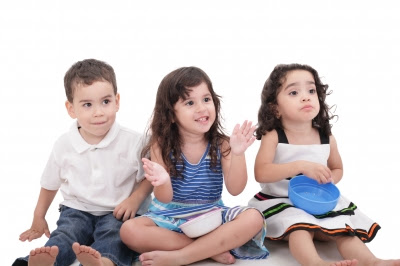
As Montessori teachers, we see daily evidence of the importance of language in early childhood development. We also observe how easily and avidly young children acquire language and build vocabulary. This inclination for language occurs because children are experiencing the sensitive period for language development from birth until about age six. From infancy, the need to communicate with others drives a child’s language progression from sounds to words to conversation. During the sensitive period for language, children are most interested in learning the names for everything around them. And as they expand their vocabulary, children are feeding their inclination to learn and develop.
While the young child is learning his native or primary language, he also has a great aptitude for learning to speak and understand a second or even third language at the same time.
This may surprise many adults who consider learning a second language to be difficult. However, as Dr. Montessori said, the reason adults have difficulty learning a second language is because they are no longer in that sensitive period for language acquisition. What is difficult for adults can be quite simple for young children, who quickly acquire fluency and can develop nearly native pronunciation and intonation. (Marcos, 2009)
Developing Citizens of the World with Montessori: Teaching and Learning a Second Language
There are generally two types of language programs taught in Montessori schools. The first and probably more popular, is exploratory classes in which children are taught the rudiments of vocabulary and grammar while being introduced to a new culture. These classes meet for a short period of time (often 30 minutes) once or twice a week, and they are intended as a basis for further learning. Children often do not attain fluency in this environment. (Marcos, 2009) Schools that use exploratory language classes may also have after-school clubs where children who are interested may meet to expand and practice their language skills.
The second type of language program is immersion. Immersion programs conduct the school day entirely in the language the children are learning, or target language. This includes all lessons in all subjects. Immersion programs allow children to learn the target language similarly to the way they learned their native language — by being completely immersed in acquiring language from the environment. Children in immersion programs quickly become bilingual. As well, they learn that there is more than one way of expressing an idea or saying something, and they develop an understanding of the relationships between words and meaning. Overall, children who learn a second language develop mental flexibility as well as an increased awareness of the importance of communication with others. (Canadian Parents for French, 2007)

If your Montessori school does not have a formal language program, consider how you provide this experience in your own classroom. You can present activities related to a second language to your environment in much the same way you present native language activities to children in the Montessori 3–6 environment. Start by using everyday phrases in your speech. Simple words like “hello” and “goodbye” can be said first in English and then in the target language. As children gain understanding, you will be able to use just the target language. Nomenclature cards in the target language are also valuable for presenting new vocabulary, and they are effective even with upper elementary children. Younger children can write new words with the Movable Alphabet, while older children can create their own word labels or labeled pictures in a journal. Songs and poetry are another great way to get children excited about speaking a new language. Daily repetition will give much needed practice and reinforcement.
Most importantly, incorporate movement into your language instruction. Act out verbs like jump, run, skip, dance, sit, and stand. Add adjectives and adverbs for variety: Jump quickly. Jump quietly. Jump quietly and quickly. Prepositions make it even more fun: Jump quickly and quietly around the green chair, then skip out the blue door, and run around the tree. The more movement you incorporate into your language lessons, the more students will understand, remember, and apply.
The need for global awareness and understanding has never been so great. Our world is rapidly changing as technology bridges the gap between people and cultures. Being fluent in more than one language will be of great benefit for children as they become true citizens of the world.
For more ideas for incorporating language learning into your Montessori environment, you may like to visit:
- TPR (Total Physical Response) World (Teaching language through movement)
- Teach Me: Enriching Children Through Language Learning (“CDs that introduce children to new languages by using familiar songs and stories.”)
- Sing, Dance, Laugh, and Eat Quiche (“Specializing in songs and materials in French, Spanish, German, and English”)
As much as possible, NAMC’s web blog reflects the Montessori curriculum as provided in its teacher training programs. We realize and respect that Montessori schools are unique and may vary their schedules and offerings in accordance with the needs of their individual communities. We hope that our readers will find our articles useful and inspiring as a contribution to the global Montessori community.
© North American Montessori Center - originally posted in its entirety at Montessori Teacher Training on Tuesday, September 10, 2013.
© North American Montessori Center - originally posted in its entirety at Montessori Teacher Training on Tuesday, September 10, 2013.

0 comments:
Post a Comment
Have questions or comments? Let us know what you thought about this article!
We appreciate feedback and love to discuss with our readers further.